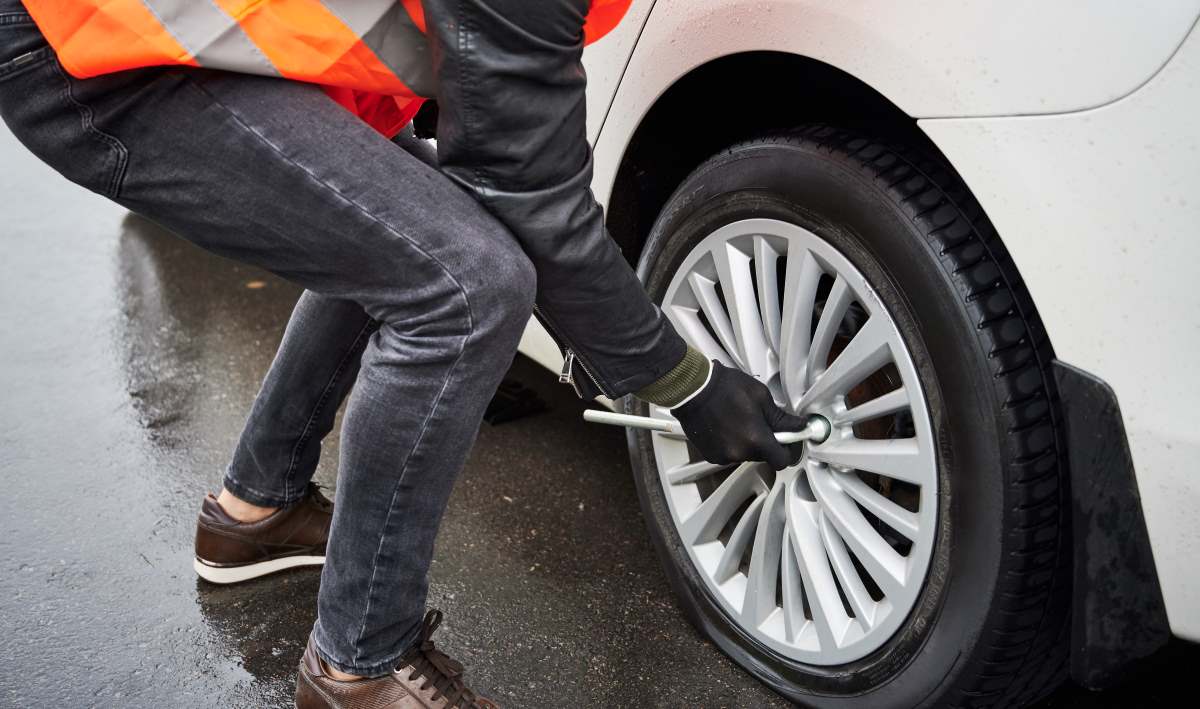9000+ Cashless Garages
96% Claims Settled (FY 24-25)

9000+ Cashless Garages
96% Claims Settled (FY 24-25)



Getting a punctured tubeless tyre can be annoying and inconvenient, particularly while travelling or in a rush. However, knowing the signs that show a puncture has occurred and how to address them can save time and money.
This article outlines the repair process for a tubeless tyre puncture and identifies some common signs that can often indicate whether a tyre is damaged. Therefore, regardless of whether you are a novice or an experienced driver, understanding how to handle such issues can protect you and keep your vehicle in good condition.


A tubeless tyre is a tyre that does not contain an inner tube to hold air pressure; instead, it features a sealed design that retains its ability to contain air pressure, as the interior surface bonds with the wheel. The inner rim has machined surfaces that mate with the tyre, allowing the air to contain pressure without leaking due to an airtight connection.
The main benefits of tubeless tyres are the reduced chance of a puncture causing rapid loss of pressure through air leakage, better fuel efficiency due to lower rolling resistance, and increased safety, as they are less vulnerable to "blowouts" than traditional versions with inner tubes. Tubeless tyres are increasingly used in cars, motorcycles, bicycles, and even heavy vehicles.
A tubeless tyre puncture can occur for various reasons, often due to external factors or improper maintenance. Identifying the common causes can help you avoid potential issues and ensure the longevity of your tyres. Here are some:
Sharp Objects on the Road: Punctures are more common due to sharp objects like nails, glass shards, or metallic debris that can pierce through the tyre tread. Even tiny objects, such as screws or rocks, can puncture the tyre if they become lodged.
Underinflation: If a tyre is underinflated, the rubber becomes more vulnerable to damage from road impacts or debris that may puncture it. Low pressure increases friction and heat, which can damage the tyre and increase the risk of punctures.
Overloading a Vehicle: Any load exceeding the capacity of a tyre increases the stress on the rubber, which raises the risk of a puncture. Overloading will also cause uneven tyre wear, with specific areas prone to further damage.
Improper Tyre Maintenance: Tyres with worn tread and cracks are most vulnerable to punctures. Punctures often happen to these tyres, especially on bumpy road surfaces. Failure to regularly check and maintain tyres leads to punctures.
Road Conditions: Potholes, sharp edges, and poorly maintained roads may cause sudden impacts that will puncture tubeless tyres. Areas with loose gravel, nails, or other debris from construction work pose the greatest risk to tyres.
Valve Stem Problems: A cracked or faulty valve stem causes air leaks in the tubeless tyre to deflate slowly or suddenly. Air loss may occur if the valve is not installed correctly or if the seal is not properly sealed when the tyre is mounted.
Tyre Age and Condition: As tyres age, the rubber compounds break down, become brittle, and are more susceptible to punctures. The rubber will deteriorate with age, leading to cracks. This happens when exposed to UV light, heat, or chemicals.
Tyre Debris from Other Vehicles: Tyre debris from other vehicles. Other vehicles may shed a part of their tread, which can puncture your tyres when they encounter them. Tyre debris from accidents remains on the road and punctures the tyres of passing vehicles.
Detecting a puncture in a tubeless tyre in the early stages would avoid further damage and guarantee safe driving. Here are some common signs that indicate your tubeless tyre may have a puncture:
| Signs | Description |
| Sudden Loss of Air Pressure | If the air pressure decreases rapidly, you should suspect a puncture. You may experience a flat tyre or an audible drop on your dash monitoring system. |
| Visible Bulges or Deformities | Punctures to tubeless tyres can cause the tyre to bulge out or become visibly distorted on the rubber. This happens because the tyre's inner structure is sick, leaving air pockets beneath the surface. |
| Loss of Handling or Stability | If your car feels unstable or harder to drive, especially at higher speeds, it may be a sign that one wheel is being held at a different pressure due to a puncture. It may also vibrate or pull to one side. |
| Fuel Efficiency Drops | If the fuel economy of your car suddenly drops, a slow leak may be a concern. This is because under-inflation causes additional rolling resistance, increasing fuel consumption. |
| Uneven Tyre Wear | A puncture will lead to uneven wear patterns on the affected tyre. Uneven tread wear in one area may be a cause for concern, as it indicates that the tyre has sustained a minor puncture and is leaking air. |
| Warning Lights or Alerts | Many of the latest vehicles have a very important function built into them, namely, TPMS, the tyre-pressure monitoring system. It will give you a warning light or an alert about low tyre pressure or puncture. |
Before you begin to repair a tubeless tyre, it is crucial to gather the right tools to ensure a safe, effective repair. Here are some tools to help you fix a flat, tubeless tyre:
| Item | Description |
| Tyre Repair Kit | A tubeless tyre repair kit typically includes rubber plugs (or tyre repair strings), a reaming tool, and an insertion tool, all of which are essential for sealing a puncture. |
| Air Pump or Compressor | After the repair, you'll need an air pump or a portable tyre compressor to reinflate the tyre. |
| Pliers | It can remove debris like nails or sharp objects from the punctured area of the tyre. |
| Valve Core Tool | If the air leaks through the valve stem, this tool can be used to remove and replace the valve core. |
| Soapy Water or Water Spray | To help locate the puncture, you spray soapy water on the tyre; the bubbles that form will be where air is escaping. |
| Tyre Levers | These are meant to pry off the tyre from the rim when you need to look inside for bigger punctures or other damage. |
| Rag or Cloth | A clean rag or cloth will come in handy to wipe down the tyre and the area before and after the repair. |
| Gloves | Wear gloves to protect your hands while handling the tyre, particularly when dealing with sharp objects or dirty surfaces. |
Follow these steps to ensure that you can safely repair a tubeless tyre puncture effectively and not lose too much time while travelling:
Step 1: Locate the Puncture: Inspect the tyre to identify the puncture. If it cannot be seen, spray some soapy water or a water spray around the tyre. Bubbles will appear where the air is escaping. Mark the puncture location for easier identification when repairing.
Step 2: Prepare the Puncture Site: Use your repair kit to clean and expand the puncture opening with the help of a reaming tool, ensuring the rubber plug grips well. Rotate the remaining tool in and out to polish out the jagged edges around the puncture.
Step 3: Insert the Repair Plug: Take a rubber plug (tyre repair string) and pass it through the insertion tool. Push the insertion tool straight into the hole with the plug inserted in the puncture hole. The plug should be inserted halfway, with both ends protruding from the tyre.
Step 4: Trim Excess Plug: Slowly draw the insertion tool out of the tyre while leaving the plug in place. Cut off the excess plug material from the tyre using scissors or a knife. Allow a small space above the tyre's surface for the plug to stay in place.
Step 5: Inflate the Tyre: Inflate the tyre with air using an air pump or compressor to the recommended pressure. Spray soapy water around the repair area and check for any air leaks. If you find bubbles, the plug hasn't sealed properly, and you must repair it.
Step 6: Check Proper Seal: Following re-inflation, inspect for signs of further air leakage at the puncture site. If the puncture is sealed correctly, it should not leak. If you had to remove the tyre from the rim, now is the time to put it back.
Step 7: Test the Vehicle: Drive the vehicle slowly for a short distance at a low speed before accelerating to high speeds to ensure the repair is secure and the tyre works correctly. Monitor the tyre pressure over the following days for slow leaks.
Certain precautions can prevent punctures in your tubeless tyres, thus extending their lifespan. Here are some primary preventive measures to keep your tyres in the best state to avoid damage:
Knowing how to repair a tubeless tire and identifying the common signs of a puncture saves time and money, helping to avoid an unwanted breakdown. Identify minor punctures by being aware of the early signs and perform the correct repair process. Moreover, one can minimise the risk by taking a few precautions.